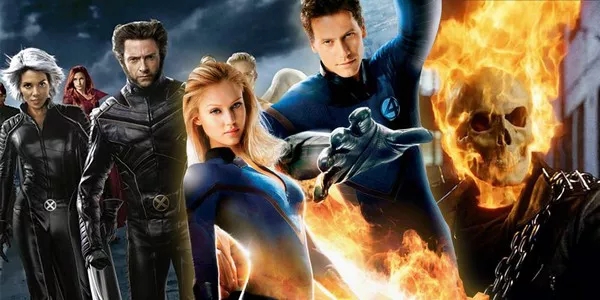Fifty years ago, the release of two films – Jaws in 1975 and Star Wars in 1977 – changed movies, America and the world, not just by creating the “blockbuster mentality” but by ushering in the cinematic age of all-popcorn-all-the-time. There were precursors, of course. In retrospect, much of our fantasy culture sprang from the loins of J.R.R. Tolkien. And there was a film that preceded “Jaws” and “Star Wars” that I think had almost as big an impact on film culture: “The Exorcist. That said, Steven Spielberg and George Lucas are undeniably the transcendental game-changers of the second half of the Hollywood century. It’s a fact that has rightly become a myth.
In many ways, the Age of Marvel is also a mythology, one that’s often been thought of as an accelerated sequel to the Lucas/Spielberg revolution. Not that the rise of comic book movie culture happened overnight. It happened gradually, over decades, starting in 1978 with ‘Superman’, building through the ’80s with the ‘Superman’ sequels and, in 1989, the next-level marketing juggernaut that was Tim Burton’s ‘Batman’ and its scattered sequels, then reaching a new plateau of centrality in 2002 with the release of ‘Spider-Man’. By the mid-2000s, it felt like we were swimming in comic book movies – but how quaint that feeling seems now, given that even then we had no idea what we were in for.
On 2 May 2008, Paramount released Iron Man, the first entry in the Marvel Cinematic Universe, and depending on your point of view, that date was either Hollywood’s answer to Christmas or the end of cinema as we knew it. The post-Marvel world was, in some fundamental ways, a lot like the post-Lucas/Spielberg world: a shiny new galaxy of escapism, of feel-good fantasy designed to seduce your eyeballs and melt your brain.
But there’s a difference in how we think about the two eras. In the mid-80s, when the addictive culture of technologically driven cinematic junk food had taken over, no one was fantasising about putting the genie back in the bottle. There was no way we were ever going back to a world before Jaws and Star Wars, Sly and Arnold, Top Gun and Flashdance. But because comic-book movies are such a specific genre in their tangled sprawl, the idea that they might one day actually disappear, leaving movies free to be whatever they were before, retains a powerful hold on many viewers.
The Marvel filmmaking machine, as captured in Tatiana Siegel’s startling Variety cover story, is now in a moment of collapse. The gears are coming off, the numbers aren’t there, the era of peak superhero may have finally passed its peak. And, of course, this is really about something bigger than mismanagement, mediocre sequels or the legal morass of Jonathan Majors. If this week’s Marvel movie – almost fatefully titled ‘The Marvels’ – turns out to be the box-office disappointment that early tracking suggests it could be, it will add to the perception (fair or unfair; I’d say fair) that audiences, overwhelmed by Marvel’s entertainment product on the big and small screen, are growing weary of it. Fan enthusiasm isn’t on life support (yet), but the original thrill is (mostly) gone.
Seasoned moviegoers know in their bones that all genres have their day, that every cinematic form eventually comes and goes. Nothing can last forever, and that includes the MCU (and yes, fans, I’m aware that we still have James Gunn’s DC). So if we’re now in the early stages of the endgame, what comes next? Many consider the MCU to have been a blight on cinema, a virus of processed storytelling and CGI overkill that invaded mainstream cinema and poisoned it from within. It poisoned the harvest. If the age of Marvel is over, can cinema recover?
We’re at a moment, symbolised by everything from the epochal success of “Oppenheimer” to the eloquent anti-Marvel sentiments of Martin Scorsese, when people are yearning for a return to what movies used to be. A return to films for adults, with supple scripts, great acting and real human drama, experienced as a communal event in the cinema. Awards season, with its symbolic abundance of films that are just that, always evokes nostalgia for a time when films were the art form of our time.
But let’s face it. That ethos, while still hanging on (it lives every time you see a great film), wasn’t just threatened by Marvel. The body blows started long before that. Our whole culture of escapism, of cinema as dehumanised, effects-laden fantasy, has been entrenched for far too long.
If you want a preview of what movies might become after the age of Marvel, look no further than the monster success of Five Nights at Freddy’s, a silly-scary horror trifle that became as big as it is because it’s based on a video game that’s bigger than movies. Video game movies have historically sputtered, but this year the makers of The Super Mario Bros. Movie got it right, and so did the makers of Five Nights at Freddy’s – commercially, at least. The infiltration of video games into the hearts, minds and reflexes of young people is a process that’s been building for decades (just like the rise of comic book movies). Could we only now be entering the sweet spot of video game cinema? If so, it would make the Age of Marvel look like the Italian Renaissance.
The real problem is not, and never has been, “the junk Hollywood makes” (as if we’re all being force-fed). It’s the junk that Hollywood makes because audiences vote for those films with their ticket dollars. That’s the way movies have always worked, never more so than in the era of zippy populist escapism ushered in by Lucas and Spielberg. That legacy was fully in place when the MCU was just a gleam in Kevin Feige’s eye. It will still be there when the MCU fades. The question is: can movies move away not just from comic books, but from the narcotic lure of compulsive fantasy, and return to something that looks more like the real world? Can cinema-goers vote for it? If not, we’re all doomed to replace the superhero spectacle with something equally lacking in nourishment.
























